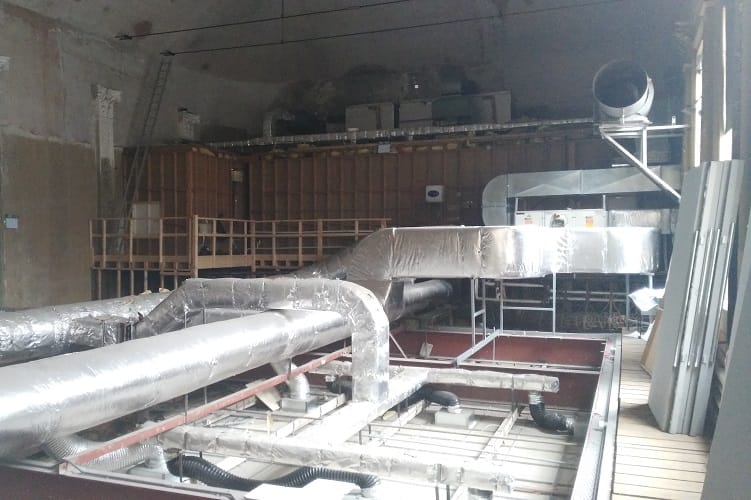What’s the best way to tell area residents about plans for a new asylum shelter nearby?
The government should tell communities directly about plans for new asylum shelters, some activists and politicians say.
Some councillors have long wanted the room in the old Rathmines Town Hall opened up for wider use.

Principal Bernadette Moore stops to collect a set of keys from the porter, before winding her way through empty halls and classrooms of the Rathmines College of Further Education.
Here at the centre of what used to be Rathmines Town Hall, she opens up an unusual historic community resource – an old, unused concert hall.
A small room housing a hefty photocopier leads into the music hall through a short door, revealing the tinfoil-wrapped pipes of a sizeable heating system.
There’s a drop onto the temporary ceilings of the classrooms below the hall. But a little creative leaning reveals a half-moon stage behind the pipes, framed by ornate green and gold trumpets and flowers.
Built in 1895, the town hall was used as a meeting place for commissioners of the Rathmines Township, the equivalent of today’s councillors.
Still owned by Dublin City Council, the building is on a 100-year lease to the City of Dublin Education and Training Board (CDETB), says Labour Councillor Mary Freehill.
Moore has worked at the college as principal for seven years, and remembers finding out about the hall. “My ambition would be to restore the concert hall to its original glory,” she says. “That would be monumental.”
But the college is already tight for room, she says, so before they could think about any kind of restoration, the college would need more space to expand into.

A Space Question
Moore leads the way to an empty classroom, down the steps from the old stage door.
“We’re under it now,” she says, and points to the semi-permanent walls of one of five classrooms built under the seating area of the concert hall.
Though removable, the walls are pretty solid, and it would be a huge job to take them down.
The hall was built to seat 2,000 people, with a “horse-shoe gallery for 500 at one end, and a platform and orchestral gallery at the other”, according to Séamas Ó Maitiú’s book Rathmines Township 1847–1930.
Moore indicates the curvature of the wall behind the teacher’s desk. We’re right under the stage. Pillars to the sides of the walls continue upwards through the temporary ceilings, supporting the heating pipes above.
“We don’t have enough room as is. Each room is busy,” she says. “In order to progress the re-establishment of the concert hall we’d have to have more space for more classrooms, even before funding.”
On top of that, they’d love to have a bigger library, computer rooms, and more spaces for students to work and study, says Moore. Right now, there’s a study room, but it’s too small for the roughly 700 students enrolled.
When DIT’s Grangegorman campus opened its doors to students in 2014, there was some talk that the eventual move there of the Rathmines branch – which is just down the road – could make room for the college of further education, says Green Party Councillor Patrick Costello.
But right now, there’s no solid plan for that, and when the DIT building eventually becomes available, Moore says, the Department of Education may well have other ideas for it.
Both Costello and Labour’s Freehill have a vision that, if reopened, the building and its concert hall could be used as a local area office.
The CDETB makes great use of it, says Costello, but the building has great potential to meet local needs.
“It’s an absolute shame that this space is there. It could be useful for the community and the college. We would absolutely want it to be shared with the people of Rathmines,” says Moore.
Curiously, according to Ó Maitiú’s history, although the hall held many concerts and events over the years, it never quite became the centre of entertainment the Rathmines Township commissioners had hoped for, and it was regularly rented out.
The first public event held there was an 1897 performance of Handel’s Messiah, and in 1899, Guglielmo Marconi gave a demonstration of his “new fangled wireless”, writes Ó Maitiú.
Now, the DIT music school’s concert orchestra could use it, says Moore. As could the Rathmines-Rathgar Musical Society.
“We could even have our own artistic department. If they ever did it, we could get involved in some more of these courses,” she says. “The uses could be hugely varied. It’s crying out for someone to love it.”
Get our latest headlines in one of them, and recommendations for things to do in Dublin in the other.